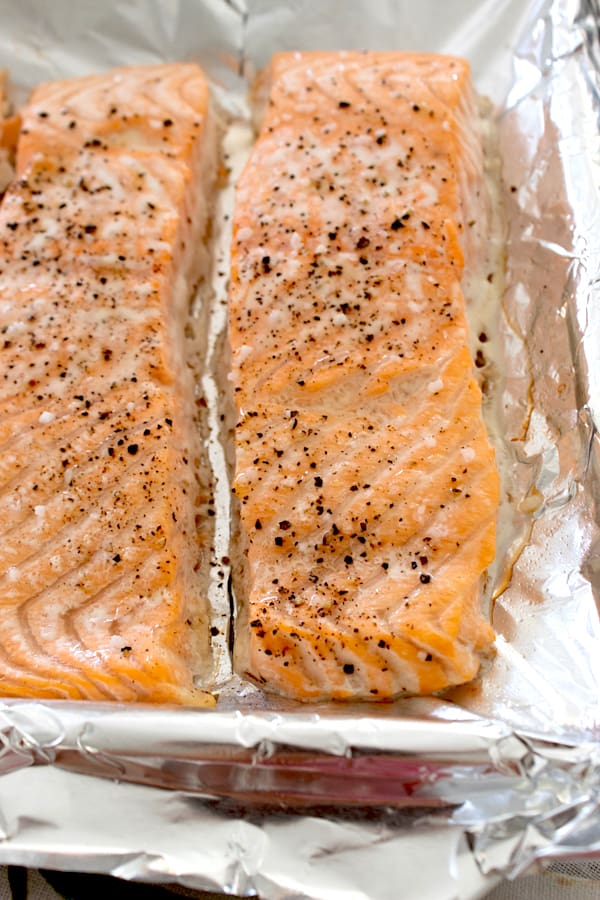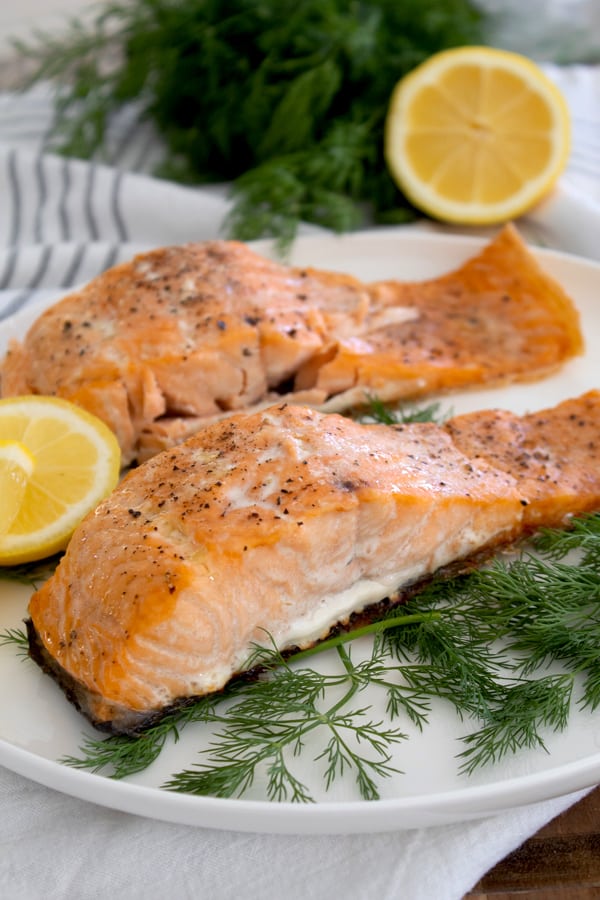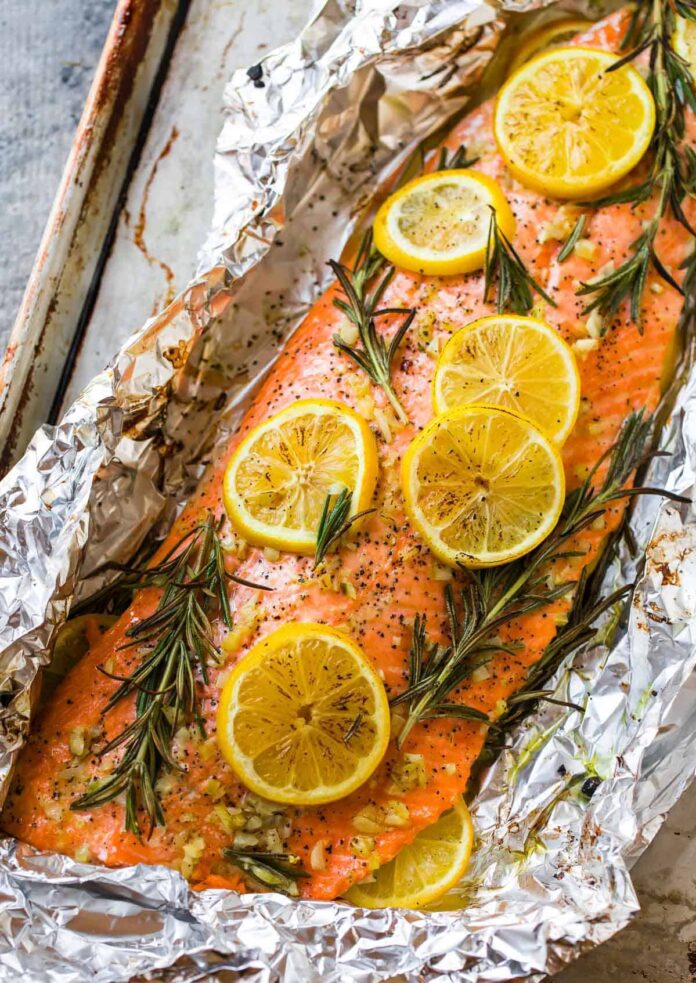Bake salmon at 400°F for 12-15 minutes until internal temperature reaches 145°F. Cooking times may vary based on thickness.
Salmon is a versatile and delicious fish that can be prepared in various ways to suit different tastes. Baking salmon at 400°F is a popular method that results in a tender and flavorful dish. Whether you prefer a simple seasoning or a more elaborate marinade, baking salmon at this temperature ensures that it cooks evenly and retains its moisture.
In this blog post, we will explore the process of baking salmon at 400°F, including tips for achieving the perfect dish every time. Whether you are a seasoned chef or a novice cook, mastering the art of baking salmon at 400°F is sure to impress your family and friends.
Perfect Baking Time For Salmon
For perfect baked salmon at 400°F, cook for 12-15 minutes. Place the salmon in a preheated oven and bake until it reaches an internal temperature of 145°F. The result is tender, flaky salmon with a deliciously crisp exterior.
Why 400 Degrees?
When it comes to baking salmon, choosing the right temperature is crucial. 400 degrees Fahrenheit is the ideal temperature for baking salmon. This temperature allows the salmon to cook evenly while developing a crispy and flavorful crust on the outside.
Ideal Internal Temperature
To ensure that your salmon is perfectly cooked, it’s essential to know the ideal internal temperature. The ideal internal temperature of salmon should reach 145 degrees Fahrenheit. You can use a meat thermometer to check the temperature of the salmon. Insert the thermometer into the thickest part of the salmon, making sure not to touch the bone.
Baking Time For Salmon At 400 Degrees
How Long to Bake Salmon at 400? The baking time for salmon at 400 degrees will depend on the thickness of the salmon. As a general rule, you should bake salmon for 12-15 minutes per inch of thickness. For example, if your salmon is 1 inch thick, you should bake it for 12-15 minutes. If your salmon is 2 inches thick, you should bake it for 24-30 minutes.
Tips For Perfectly Baked Salmon
- Pat the salmon dry with a paper towel before baking to ensure a crispy skin.
- Season the salmon generously with salt, pepper, and other desired spices.
- Brush the salmon with olive oil or melted butter before baking to keep it moist.
- Let the salmon rest for a few minutes after baking to allow the juices to redistribute.
In conclusion, baking salmon at 400 degrees Fahrenheit for 12-15 minutes per inch of thickness is the perfect baking time for salmon. By following these guidelines, you can achieve perfectly cooked and flavorful salmon every time.

Credit: laughingspatula.com
Preparing Salmon For Baking
Before you start baking your salmon, it’s important to prepare it properly to ensure a delicious and flavorful outcome. This involves choosing fresh salmon and applying the right preparation techniques. In this section, we will explore how to select the best salmon and the steps to take before placing it in the oven.
Choosing Fresh Salmon
When it comes to cooking salmon, freshness is key. Follow these guidelines to choose the freshest salmon for baking:
- Look for salmon with bright, shiny skin and firm flesh.
- Ensure that there are no signs of discoloration or browning on the flesh.
- Check for a mild, oceanic scent, which indicates freshness.
- Opt for wild-caught salmon when available, as it tends to have a richer flavor and more vibrant color compared to farmed salmon.
Preparation Techniques
Once you have selected your fresh salmon, it’s time to prepare it for baking. Follow these simple steps:
- Start by preheating your oven to 400°F (200°C) to ensure it reaches the ideal temperature for baking.
- Line a baking sheet with parchment paper or lightly grease it to prevent the salmon from sticking.
- Place the salmon fillets or steaks on the prepared baking sheet, skin-side down.
- Season the salmon with your choice of herbs, spices, or marinade to enhance its flavor. Some popular options include dill, lemon, garlic, and soy sauce.
- For added moisture and flavor, drizzle the salmon with a small amount of olive oil or melted butter.
- If desired, you can also add slices of lemon or other citrus fruits on top of the salmon for an extra burst of freshness.
By following these preparation techniques, you’ll be on your way to baking a perfectly cooked and flavorful salmon dish. The next step is to determine the appropriate cooking time based on the thickness of your salmon fillets or steaks.
Marinating For Flavor Enhancement
Marinating salmon is a fantastic way to add flavor and enhance the taste of this delicious fish. By allowing the salmon to soak in a flavorful marinade, you can infuse it with a variety of seasonings, herbs, and spices, creating a mouthwatering dish that will leave your taste buds wanting more. Whether you prefer a quick marinade or a longer marination timeframe, taking the time to marinate your salmon before baking it at 400 degrees Fahrenheit can make all the difference in the final result.
Quick Marinade Recipes
If you’re short on time and still want to enjoy a flavorful salmon dish, these quick marinade recipes are perfect for you:
- Lemon Dill Marinade: In a bowl, combine the juice of one lemon, a tablespoon of olive oil, a teaspoon of dried dill, and a pinch of salt and pepper. Coat the salmon fillets with the marinade and let them sit for at least 15 minutes before baking.
- Teriyaki Marinade: Mix together a quarter cup of soy sauce, two tablespoons of honey, a tablespoon of minced garlic, and a teaspoon of grated ginger. Pour the marinade over the salmon and let it marinate for about 30 minutes before baking.
Marination Timeframes
The longer you marinate the salmon, the more intense the flavors will become. Here are some marination timeframes to consider:
| Marination Time | Flavor Intensity |
|---|---|
| 15 minutes to 1 hour | Mild flavor enhancement |
| 1 to 4 hours | Medium flavor enhancement |
| 4 to 24 hours | Intense flavor enhancement |
Keep in mind that marinating the salmon for too long can result in a mushy texture, so it’s important to find the right balance based on your personal preference.
So, whether you opt for a quick marinade or a longer marination timeframe, marinating your salmon before baking it at 400 degrees Fahrenheit will undoubtedly elevate its flavor profile. Experiment with different marinades and timeframes to discover your favorite combination and enjoy a delightful salmon dish that is bursting with flavor.
Seasoning Ideas For Baked Salmon
When it comes to baking salmon, the right seasoning can take your dish from ordinary to extraordinary. Whether you prefer classic flavors or want to get creative with unique blends, there are endless possibilities to enhance the taste of your baked salmon. In this article, we’ll explore some delicious seasoning ideas that will make your salmon burst with flavor.
Classic Herbs And Spices
Classic herbs and spices are a timeless choice for seasoning baked salmon. These tried-and-true flavors complement the natural richness of the fish, creating a harmonious and satisfying combination. Here are some popular options:
- Dill: Known for its fresh and vibrant taste, dill adds a pleasant herbal note to salmon. Sprinkle some fresh or dried dill over the fish before baking for a burst of flavor.
- Lemon and Garlic: The zesty tang of lemon and the pungent aroma of garlic create a delightful pairing for salmon. Squeeze fresh lemon juice over the fillets and rub them with minced garlic for a simple yet delicious seasoning.
- Black Pepper and Sea Salt: Sometimes, simplicity is key. A generous sprinkle of freshly ground black pepper and a pinch of sea salt can bring out the natural flavors of salmon without overpowering them.
Creative Seasoning Blends
If you’re feeling adventurous, why not try some creative seasoning blends to elevate your baked salmon to new heights? These unique combinations will add an unexpected twist to your dish:
| Seasoning Blend | Ingredients |
|---|---|
| Asian-inspired: | Soy sauce, ginger, sesame oil, and a touch of honey |
| Mediterranean: | Oregano, thyme, rosemary, lemon zest, and a drizzle of olive oil |
| Spicy Cajun: | Paprika, cayenne pepper, garlic powder, onion powder, and a pinch of cumin |
Feel free to experiment with different seasoning blends and adjust the quantities to suit your taste preferences. The key is to have fun and explore exciting flavor combinations that will make your baked salmon truly memorable.
By using these seasoning ideas, you can turn a simple piece of salmon into a mouthwatering masterpiece. Whether you opt for classic herbs and spices or get creative with unique blends, your baked salmon will undoubtedly be a hit at the dinner table.
Baking Techniques
Baking techniques play a crucial role in determining the flavor and texture of salmon. The method you choose can significantly impact the outcome. Let’s explore the various baking techniques for preparing delicious salmon at 400 degrees.
Foil Vs. Uncovered
When baking salmon at 400 degrees, you have the option to use foil or leave it uncovered. Foil helps to lock in moisture and infuse the salmon with flavor. It’s ideal for creating a moist and tender result. On the other hand, baking uncovered allows the fish to develop a slightly crispy exterior. The choice between foil and uncovered depends on the desired texture and flavor profile.
Skin Side Up Or Down?
Deciding whether to place the salmon skin-side up or down can impact the overall presentation and texture. Placing the skin-side down can result in a more moist and tender flesh. Conversely, cooking with the skin-side up allows for a crispy skin, which adds a delightful texture to the dish. Consider your preference for skin texture and presentation when making this decision.
Determining Doneness
When cooking salmon at 400 degrees, it’s crucial to ensure that it’s perfectly done. Determining the doneness of salmon is essential to achieve the ideal texture and flavor. Here are two reliable methods to determine if your salmon is cooked to perfection.
Visual Cues
Examining the visual cues can help you determine if your salmon is done. Look for a change in color from translucent to opaque. The flesh should also easily flake with a fork, indicating that it’s fully cooked.
Using A Thermometer
Another precise way to determine doneness is by using a thermometer. Insert the thermometer into the thickest part of the salmon. When the internal temperature reaches 145°F, your salmon is ready to be served.
Serving Suggestions
For perfectly baked salmon at 400 degrees, place the seasoned fillets on a baking sheet lined with parchment paper. Bake for 12-15 minutes until the fish flakes easily with a fork. Serve with a squeeze of lemon and a sprinkle of fresh herbs for a delightful meal.
Side Dishes
Enhance your baked salmon meal with delicious side dishes like:
- Freshly steamed asparagus spears
- Garlic butter sautéed green beans
- Quinoa salad with cherry tomatoes and feta
Presentation Tips
Make your salmon dish visually appealing with these presentation tips:
- Place the salmon fillets on a bed of fresh arugula
- Garnish with lemon wedges and dill sprigs
- Serve on elegant white plates for a classy touch
Common Baking Mistakes To Avoid
When baking salmon at 400 degrees, avoid common mistakes like overcooking or undercooking. Follow the recommended cooking time of 12-15 minutes per inch of thickness for perfectly baked salmon.
Overcooking Pitfalls
Don’t leave salmon in the oven too long.
Overcooking can make salmon tough and dry.
Avoiding Dryness
Prevent dryness by not exceeding baking time.
Check doneness with a fork for moistness.
Storing And Reheating Leftovers
Discover the perfect way to store and reheat your leftover salmon. Learn how long to bake salmon at 400 degrees Fahrenheit for a delicious and flavorful meal every time.
Proper Storage Methods
After enjoying your delicious baked salmon, it’s essential to store any leftovers properly to maintain freshness.
- Place leftovers in an airtight container to keep them from drying out.
- Refrigerate the salmon within two hours of cooking to prevent bacterial growth.
- Label the container with the date to track how long it has been stored.
- Store in the refrigerator for up to 3 days for the best quality.
Reheating For Best Quality
When reheating leftover salmon, follow these tips to preserve its flavor and texture.
- Preheat the oven to 275°F to warm the salmon gently without overcooking it.
- Place the salmon in an oven-safe dish and cover it with foil to retain moisture.
- Heat for about 15 minutes or until warmed through.
- Check the internal temperature to ensure it reaches 145°F for safe consumption.

Credit: laughingspatula.com
Nutritional Benefits Of Salmon
Salmon is packed with numerous nutritional benefits. It is a great source of omega-3 fatty acids, high-quality protein, and essential vitamins and minerals. Baking salmon at 400 degrees Fahrenheit for about 12-15 minutes ensures a perfectly cooked and flavorful dish.
Omega-3 Fatty Acids
Salmon is rich in omega-3 fatty acids which support heart health.
Protein And Vitamin Content
Salmon is a great source of protein and essential vitamins like Vitamin D.

Credit: www.pinterest.com
Frequently Asked Questions
How Long Does It Take To Bake Salmon At 400 Degrees Fahrenheit?
It typically takes 12-15 minutes to bake salmon at 400 degrees Fahrenheit. The exact time may vary depending on the thickness of the salmon fillet. To ensure that the salmon is cooked through, use a meat thermometer to check that the internal temperature has reached 145°F.
Can I Use Aluminum Foil To Bake Salmon?
Yes, you can use aluminum foil to bake salmon. It helps to keep the salmon moist and prevents it from sticking to the baking sheet. Simply place the salmon on a sheet of aluminum foil, season as desired, and fold the foil around the salmon to create a packet.
Bake as directed.
What Are Some Seasoning Options For Baked Salmon?
Some popular seasoning options for baked salmon include lemon and dill, garlic and herb, and Cajun seasoning. You can also try using soy sauce and ginger for an Asian-inspired flavor, or maple syrup and mustard for a sweet and tangy glaze.
Experiment with different seasonings to find your favorite.
How Do I Know When The Salmon Is Fully Cooked?
To know when the salmon is fully cooked, use a meat thermometer to check that the internal temperature has reached 145°F. The flesh should also be opaque and flaky when tested with a fork. Be careful not to overcook the salmon, as this can cause it to become dry and tough.
Conclusion
Baking salmon at 400 degrees Fahrenheit for 12-15 minutes is an ideal way to achieve a moist and flavorful dish. By following this simple method, you can enjoy a perfectly cooked salmon that is both delicious and nutritious. Experiment with different seasonings and accompaniments to create a personalized culinary experience.


